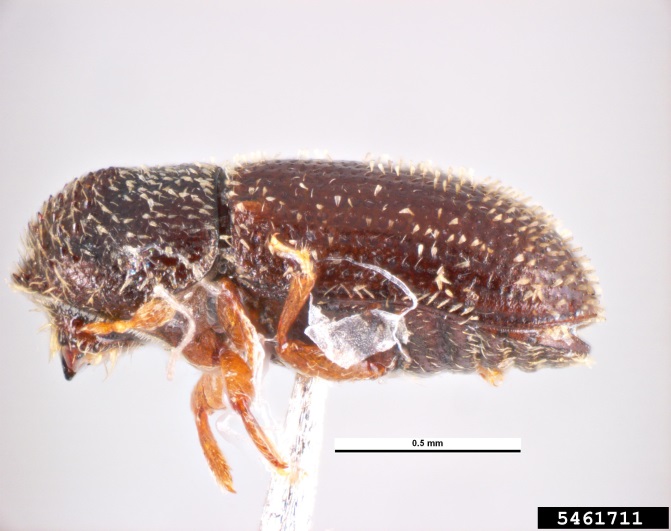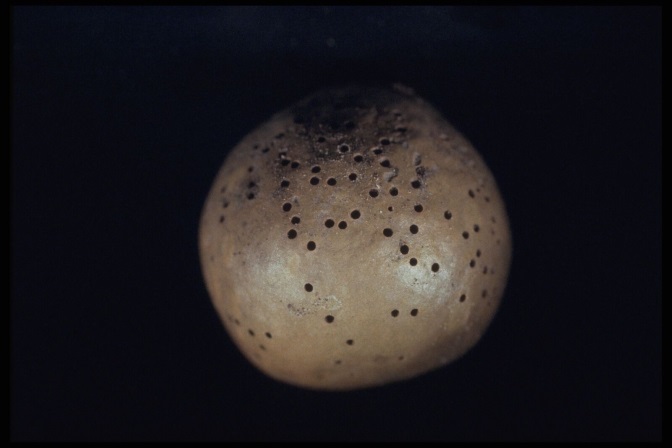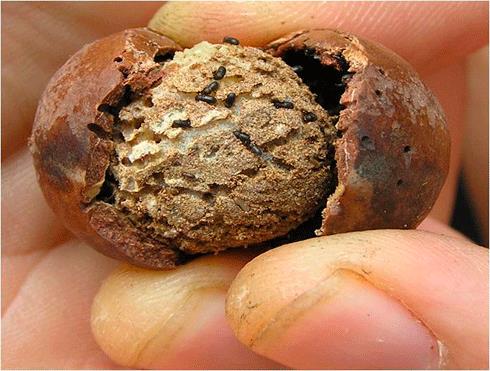
Tropical nut borer
| Primefact number | Edition | Published | Author |
|---|---|---|---|
| 1473 | First | Jul 2016 | Plant Biosecurity and Product Integrity |



Tropical nut borer (Hypothenemus obscurus) is an exotic plant pest not present in Australia. This insect is a serious threat to Australia’s macadamia industry.
Tropical nut borer is one of the most important pests of macadamia production overseas. The borers live and feed beneath the husk making it difficult to spray for them. In heavily infested areas tropical nut borers can damage to up to 60% of a macadamia crop. Up to 190 beetles have been found in a single nut.
Notifiable status
Tropical nut borer (Hypothenemus obscurus) is not a notifiable plant pest in NSW.
However, if you suspect Tropical nut borer (Hypothenemus obscurus):
- Call the Exotic Plant Pest Hotline 1800 084 881
- Email biosecurity@dpi.nsw.gov.au with a clear photo and your contact details
A full list of notifiable plant pests and diseases can be found in Schedule 2 of the NSW Biosecurity Act 2015.
Description
Tropical nut borer beetles are very small, dark brown and oblong in shape (Figure 1). Adults grow to around 1.5 mm in size.
As tropical nut borers live within infested macadamia nuts the initial sign of their presence will likely be numerous 0.5 mm holes bored into the husk of the nut (Figure 2).
Internal inspection of infested nuts will show extensive tunnelling throughout the husk, shell and kernel (Figure 3).
Damage
Tropical nut borers bore 0.5 mm holes into macadamia husks and tunnel through the husk, shell and kernel.
Damage by the borers makes nuts unmarketable and exposes them to further fungal infection.
Lifecycle
Tropical nut borer adults invade maturing husks of nuts both on the tree and on the ground. Females form galleries within the shell and kernel in which they lay up to 120 eggs each.
Larval, pupal and adult life stages are all completed within the infested nut.
Mature beetles likely exit the nut under pressure of overcrowding, food depletion or infection by secondary diseases. Multiple holes are commonly seen in mature nuts on the ground and on the trees.
Host range
Recorded hosts of tropical nut borer include macadamia (Macadamia integrifolia), Brazil nut (Bertholletia excels), coffee (Coffea spp.), cocoa (Theobroma cacao), nutmeg (Myristica fragrans), eucalyptus, pines (Pinus spp.) and Indian tamarind (Tamarindus indica).
Spread
Tropical nut borer adults spread locally by flying.
Long distance spread occurs with transport of infested macadamia nut in shell.
Distribution
Tropical nut borer is widespread in North America (including Hawaii), Canada, Central and South America.
Actions to minimise risk
Put in place biosecurity best practice actions to prevent entry, establishment and spread of pests and diseases:
- practice “Come clean, Go clean”
- ensure all staff and visitors are instructed in and adhere to your business management hygiene requirements
- monitor your orchard regularly
- keep records

